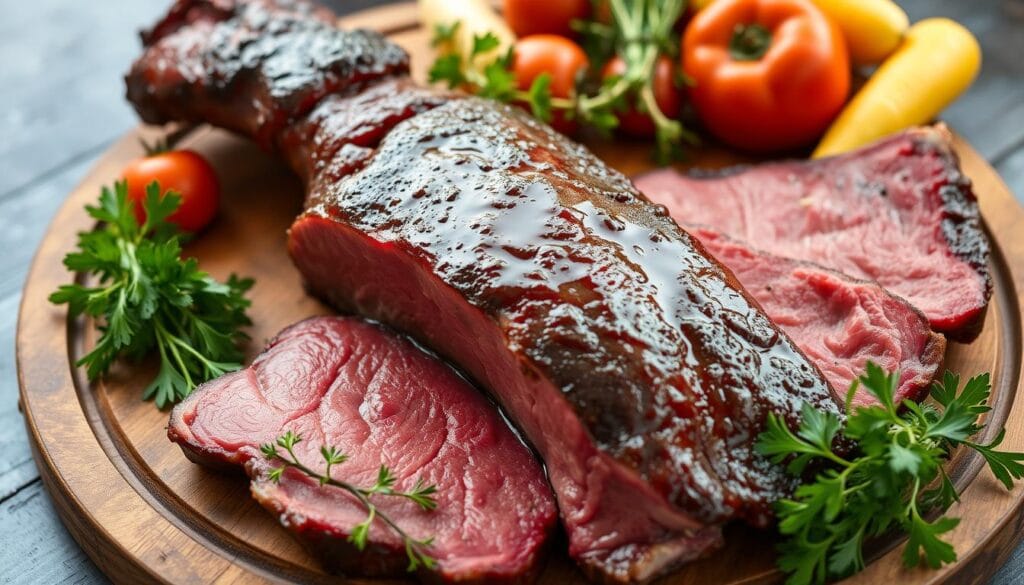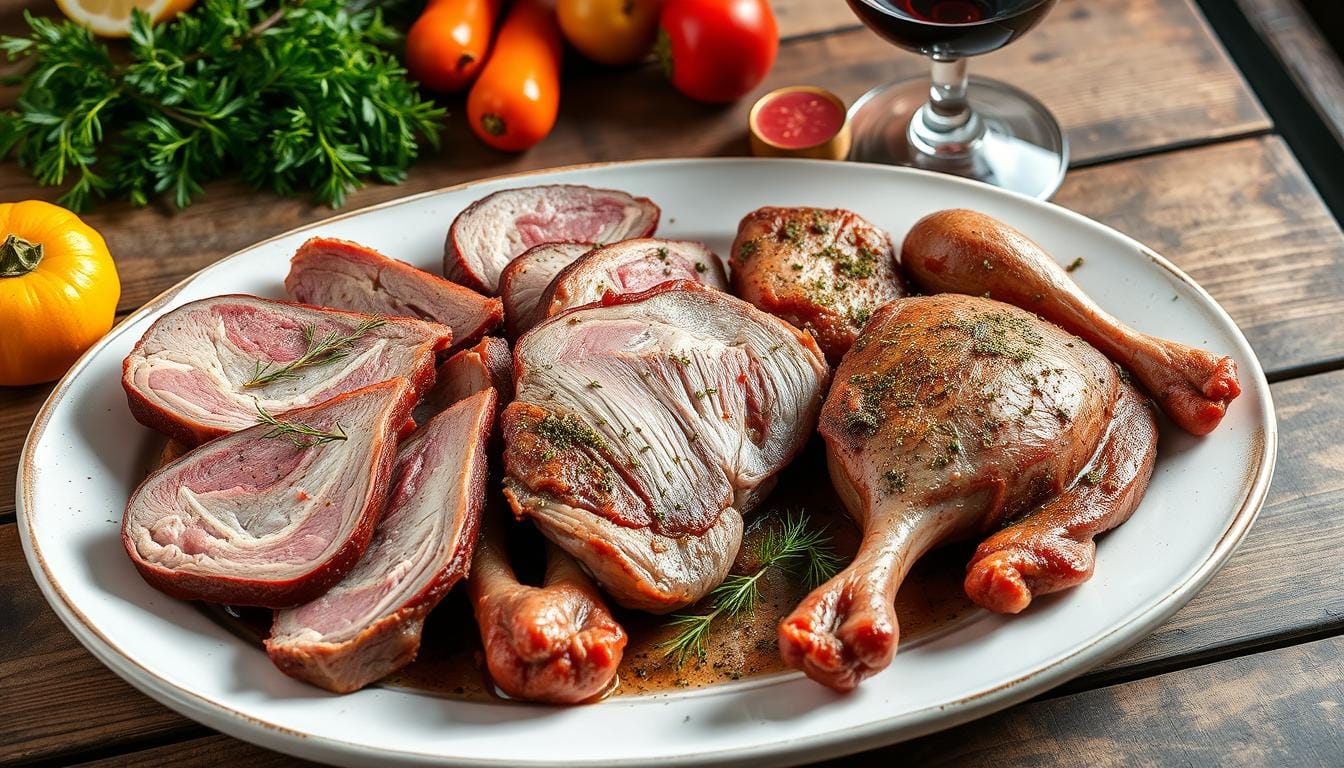Table of contents
- Key Takeaways
- Understanding Drake Meat and Its Unique Flavor Profile
- Sustainable Sourcing of Drake Meat
- Preparation Methods for Drake Meat
- Essential Tools for Preparing Drake Meat
- Marinating Drake Meat: Tips and Tricks
- Cooking Times and Temperatures for Drake
- Flavor Pairings That Complement Drake Meat
- Recipe Ideas Featuring Drake Meat
- Common Mistakes to Avoid When Cooking Drake
Ever curious about drake meat? What makes it special compared to other game birds? How can you make the most of its taste? This Vita Recipe guide will cover the unique flavor of drake meat, its health benefits, and the best ways to cook it.
Key Takeaways
- Drake meat is the leaner, more flavorful counterpart to farm-raised duck, offering a unique culinary experience.
- Proper preparation and cooking techniques are crucial to bring out the best qualities of drake meat.
- Drake meat is versatile, suitable for a variety of cooking methods, including roasting, grilling, and braising.
- Understanding the ideal internal temperatures and cooking times for drake meat can ensure a juicy and tender final dish.
- Exploring flavor pairings and creative recipe ideas can help you maximize the potential of this game bird.
But what exactly is drake meat, and how does it compare to other game birds in terms of taste and nutritional value? Let’s delve deeper into the world of this captivating culinary delight.
Understanding Drake Meat and Its Unique Flavor Profile
Drake meat comes from male ducks and has a distinct flavor. It tastes slightly gamey and is leaner than domestic ducks. This flavor comes from the duck’s diet and natural oils.
What is Drake Meat?
Drake meat, or male duck meat, is known for its intense flavor. It’s different from domestic duck, which tastes milder. Drake meat adds depth to many dishes with its robust taste.
Nutritional Benefits of Drake Meat
Drake meat is packed with nutrients. It has 175 calories, 25 grams of protein, 10 grams of fat, and no carbs per 100 grams. It’s also rich in iron, vitamin B6, and vitamin B12.
These nutrients support tissue repair, red blood cell production, and the immune system. Adding drake meat to your diet can be very beneficial.
How Drake Meat Compares to Other Game Birds
Drake meat has a unique flavor compared to other game birds. It’s richer and more intense than chicken, turkey, or quail. Its bold taste makes it versatile in cooking.
| Nutrient | Drake Meat | Chicken | Turkey | Quail |
|---|---|---|---|---|
| Calories (per 100g) | 175 | 165 | 189 | 178 |
| Protein (g per 100g) | 25 | 31 | 28 | 25 |
| Fat (g per 100g) | 10 | 5.6 | 10.8 | 9.5 |
| Iron (mg per 100g) | 3 | 1.1 | 1.4 | 3.1 |
Drake meat’s unique taste, nutritional value, and versatility make it a great choice for adventurous cooks.

Sustainable Sourcing of Drake Meat
The demand for quality game bird meat is rising. It’s key to look at the sustainability and ethics of the sourcing. Drake meat, known for its unique taste and health benefits, comes from different suppliers. Each has its own way of producing responsibly.
Where to Find Quality Drake Meat
Start looking for sustainable drake meat at local butchers, specialty meat markets, or from hunters and small farms. These places let you meet the producers. You can learn about their methods, ensuring the meat is top-notch and ethically sourced.
Choosing Ethical and Sustainable Options
- Choose drake meat from farms that let ducks roam free or are caught in the wild. This way, they can live naturally.
- Go for producers who treat animals humanely and sustainably. This reduces their environmental footprint.
- Support local and regional suppliers. They usually care more about their community and the land.
Producing sustainable drake meat means raising ducks in natural settings. This lets them live as they should, making the meat taste great. It also looks after animal welfare and the environment, pleasing those who care about these issues.

“Ethical sourcing is more than just a buzzword – it’s a commitment to ensuring the well-being of the animals and the planet. When you choose sustainable drake meat, you’re not just enjoying a delicious culinary experience, but also supporting a food system that prioritizes responsible practices.”
Preparation Methods for Drake Meat
Getting drake meat ready right is crucial for its rich, gamey taste. Whether you roast, grill, or bake, knowing the best ways can elevate your dish. It’s all about the technique.
Roasting Techniques for Drake
Roasting is a favorite for cooking whole drake or big pieces. It takes 1 to 1.5 hours at 375°F (190°C) until it hits 165°F (75°C inside). This method crisps the skin and keeps the meat juicy and tasty.
Grilling vs. Baking: What Works Best?
Grilling drake breasts at medium-high heat for 4-6 minutes each side is quick and tasty. Baking is better for different cuts, as it cooks them evenly without drying.
Brining: Enhancing Flavor and Juiciness
Marinating drake meat for 2-4 hours or overnight is key. It tenderizes the meat and adds great flavors. The brine keeps it moist and juicy while cooking.
Watch the cooking times to prevent drake meat from drying out. A meat thermometer is vital to hit the 165°F (75°C mark. Let it rest for a few minutes before serving to keep it juicy and tender.
Essential Tools for Preparing Drake Meat
Preparing delicious drake meat requires the right kitchen tools. You need specialized tools and essential utensils. The right tools can greatly improve the taste and texture of your dishes.
Must-Have Kitchen Equipment
A sharp, high-quality knife is key for preparing drake meat. A good chef’s knife or boning knife makes clean cuts easy. Also, a roasting pan for whole birds is essential for cooking the drake perfectly.
A meat thermometer is crucial for cooking the drake to the right temperature. This keeps it juicy and tender. You’ll also need a cutting board, kitchen twine, and a basting brush for marinades and sauces.
Recommended Utensils for Game Birds
- Sharp poultry shears for effortlessly breaking down the drake
- A pair of tongs for easily handling and maneuvering the bird during cooking
- A sturdy fork to help with carving and plating the cooked drake
- A basting brush for applying marinades, rubs, and sauces
Marinating Drake Meat: Tips and Tricks
Marinating drake meat is a game-changer. It makes the meat taste better and become more tender. By soaking the meat in a flavorful marinade, you can make it truly stand out.
Best Marinades for Enhanced Flavor
For marinating drake meat, mix acidic and aromatic ingredients. Acids like citrus juices, vinegar, or wine tenderize the meat. Add fresh herbs, garlic, and spices for extra flavor.
- Honey-Garlic Marinade: Combine honey, minced garlic, soy sauce, and freshly squeezed lemon juice.
- Spicy Cajun Marinade: Mix Cajun seasoning, olive oil, Worcestershire sauce, and a touch of brown sugar.
- Herbed Red Wine Marinade: Whisk together red wine, balsamic vinegar, rosemary, thyme, and a pinch of salt and pepper.
How Long to Marinate for Optimal Taste
The best marinating time for drake meat is 2-4 hours, or overnight. This lets the flavors deeply penetrate the meat. You’ll get a delicious and tender result.
“Marinating drake meat is the secret to unlocking its full potential. The right marinade can transform this unique protein into a culinary masterpiece.”
But don’t overdo it. Over-marinating can make the meat too soft. Stick to the recipe and trust your instincts for the best results.
Cooking Times and Temperatures for Drake
Preparing delicious drake meat requires knowing the right cooking times and temperatures. Whether you roast, grill, or braise it, getting the meat just right is essential. This ensures you enjoy the full flavor of this special game bird.
Ideal Internal Temperatures for Drake Meat
To ensure safety and tenderness, cook drake meat to 165°F (75°C). This temperature makes the meat juicy and full of flavor.
Cooking Times Based on Different Cuts
- Whole Drake: Roast at 375°F (190°C) for 1 to 1.5 hours, or until the internal temperature reaches 165°F (75°C).
- Drake Breasts: Grill for 4-6 minutes per side, or until the internal temperature reaches 165°F (75°C).
- Drake Legs and Wings: Braise in a flavorful liquid for 2-3 hours over low heat, until the meat is tender and the internal temperature reaches 165°F (75°C).
Always let cooked drake meat rest for 10-15 minutes before serving. This step helps the juices spread evenly, making the meat juicy and tender.
| Cut | Cooking Method | Cooking Time | Internal Temperature |
|---|---|---|---|
| Whole Drake | Roast | 1 to 1.5 hours | 165°F (75°C) |
| Drake Breasts | Grill | 4-6 minutes per side | 165°F (75°C) |
| Drake Legs and Wings | Braise | 2-3 hours | 165°F (75°C) |
Flavor Pairings That Complement Drake Meat
Choosing the right herbs, spices, and side dishes can really boost the flavors of drake meat. There are many tasty options, from strong herbs to fruity sauces.
Best Herbs and Spices for Drake
Drake meat goes great with herbs like rosemary, thyme, and sage. These herbs add earthy and woodsy flavors that match the meat’s gamey taste. Adding garlic, salt, and pepper can also bring out the meat’s natural taste.
Sides That Go Well with Drake Dishes
Pairing drake dishes with hearty sides makes for a complete meal. Roasted root veggies like carrots and potatoes add a comforting touch. Wild rice or quinoa adds a nutty texture. For freshness, try steamed or sautéed greens like kale or spinach.
When pairing drake meat, pick ingredients that highlight its flavors without overwhelming them. The right side dishes for drake can make for a delicious and balanced meal.
Recipe Ideas Featuring Drake Meat
Discover the rich taste of drake meat with these tasty recipe ideas. Whether you’re an experienced cook or new to game birds, these dishes will excite your taste buds. They show how versatile this unique ingredient can be.
Classic Drake Recipes to Try at Home
For a traditional taste, try roasting a whole drake with root. The meat goes well with roasted potatoes, carrots, and onions. It makes a warm and satisfying meal. Another classic is pan-seared drake breast with balsamic glaze. It highlights the meat’s rich flavor and the glaze’s tangy sweetness.
Creative and Unique Drake Dishes
Want to try something new? Try drake confit, where the meat is slow-cooked in its own fat. It becomes tender and full of flavor. For a twist, make drake meat tacos. The drake’s rich taste pairs well with Mexican flavors.
Make your drake dishes stand out by adding it to stir-fries, curries, or duck ragu pasta. The trick is to let the drake’s unique taste shine. Pair it with ingredients and seasonings that complement it.
“The versatility of drake meat allows you to explore a wide range of culinary possibilities. From classic roasts to innovative preparations, the rich, gamey flavor of this game bird can elevate any dish.”
When cooking with drake meat, respect its unique qualities. Let its bold flavor be the main attraction. With creativity and a bit of experimentation, you’ll find a world of delicious dishes using this exceptional ingredient.
Common Mistakes to Avoid When Cooking Drake
Cooking drake meat can be a fun experience. But, it’s key to avoid common mistakes for the best results. One big mistake is overcooking, which makes the meat dry and tough. To avoid this, use a meat thermometer to check the internal temperature and don’t go over the recommended doneness.
Overcooking: How to Prevent It
Drake meat tastes best when it’s cooked to medium-well or medium-rare. Overcooking it can make it taste bad and feel dry. To prevent this, watch the cooking time closely and use a meat thermometer. This ensures the meat reaches the perfect temperature of 145-155°F (63-68°C).
Learning from Common Drake Preparation Errors
There are other mistakes to watch out for when cooking drake. Not letting the meat rest after cooking can lose flavorful juices. Also, using strong marinades that hide the meat’s natural taste is a mistake. And, overcrowding the pan can prevent browning, leading to steaming instead.
By knowing and avoiding these mistakes, you can make the most of drake meat. With the right techniques and care, you’ll become a pro at cooking drake.
FAQ
What is drake meat?
Drake meat comes from male ducks. It has a rich, gamey taste and is leaner than domestic duck.
What are the nutritional benefits of drake meat?
Drake meat is packed with protein and has less fat. It’s a healthier choice. Its unique flavor makes it stand out among game birds.
What is the ideal internal temperature for cooked drake meat?
Cook drake meat to 165°F (75°C) for safety. Whole drakes roast for 1 to 1.5 hours at 375°F (190°C). Drake breasts grill for 4-6 minutes per side.
What flavors pair well with drake meat?
Strong herbs like rosemary, thyme, and sage go well with drake meat. Fruit-based sauces, especially berry or citrus, also complement its rich taste. Serve with roasted root vegetables, wild rice, or hearty greens.
What are some classic drake meat recipes to try?
Try roasted whole drake with root vegetables or pan-seared drake breast with balsamic glaze. For something different, try drake confit or drake meat tacos.
What are some common mistakes to avoid when cooking drake meat?
Avoid overcooking, which dries out the meat. Don’t forget to rest the meat after cooking to keep juices in. Use marinades carefully to not overpower the meat’s flavor. And, don’t overcrowd the pan when searing.

